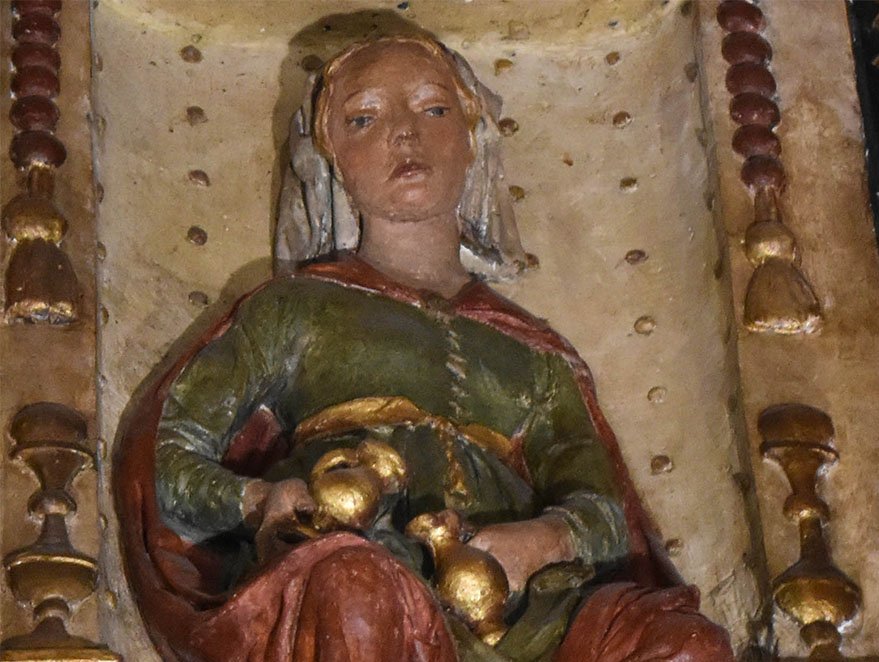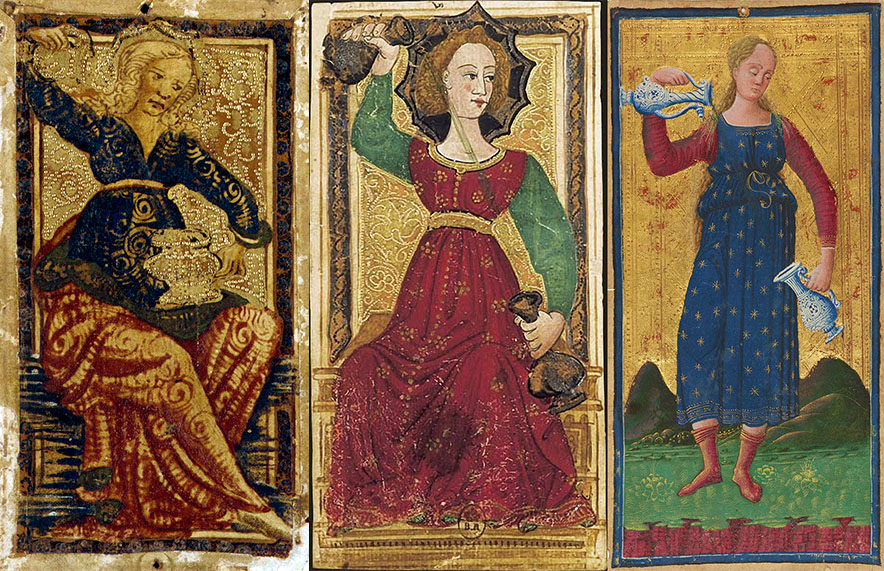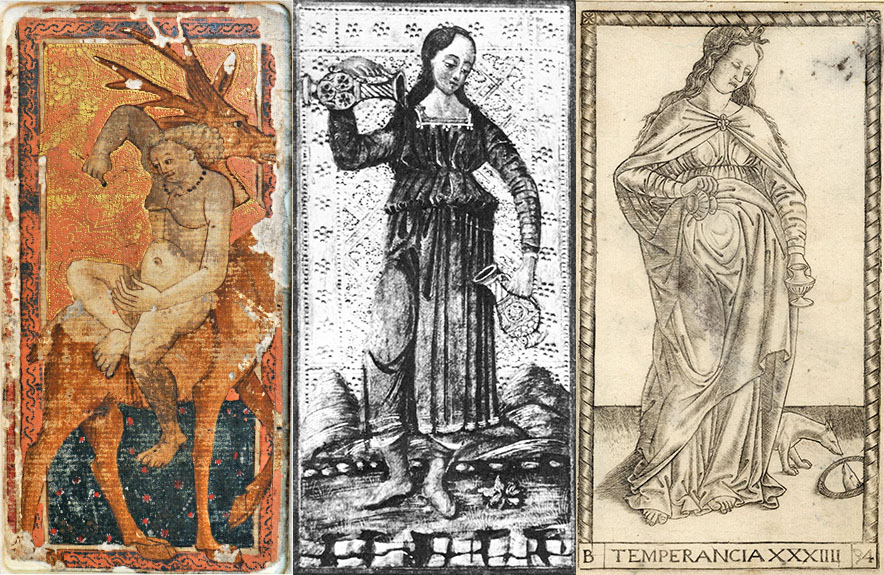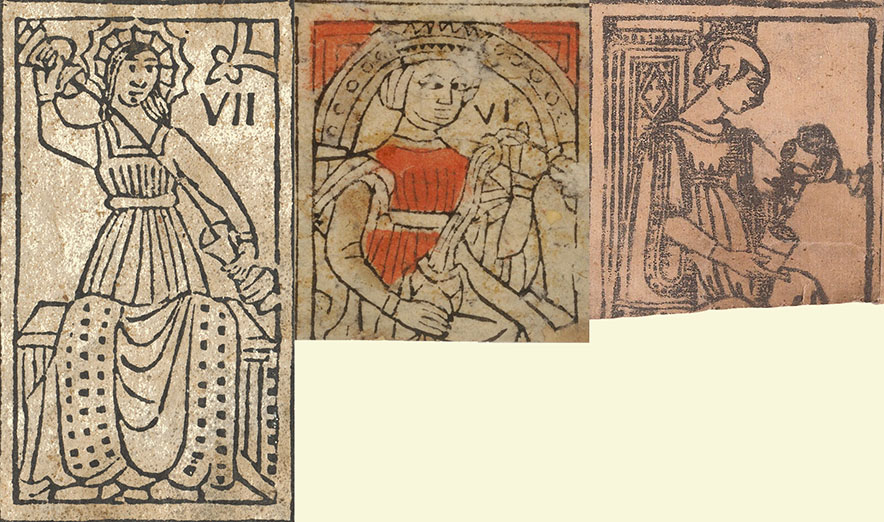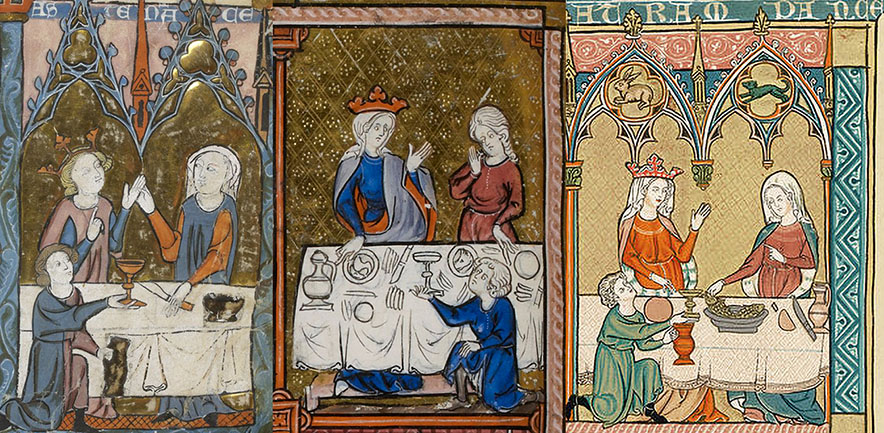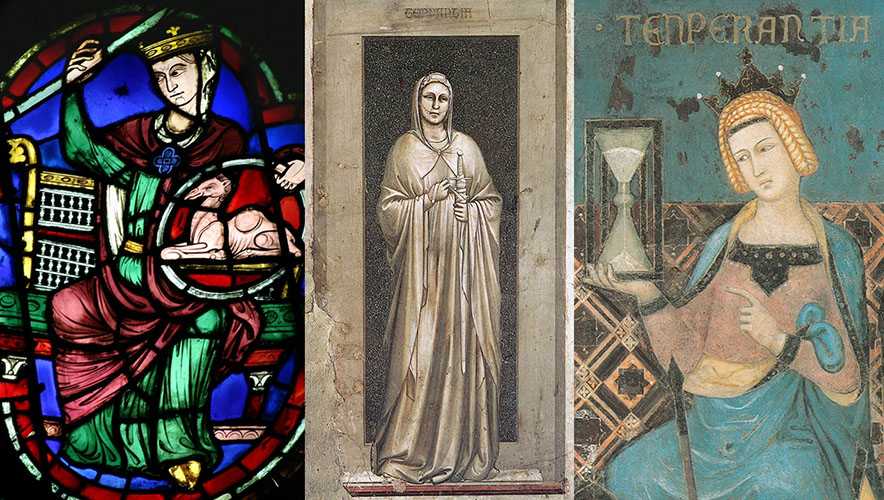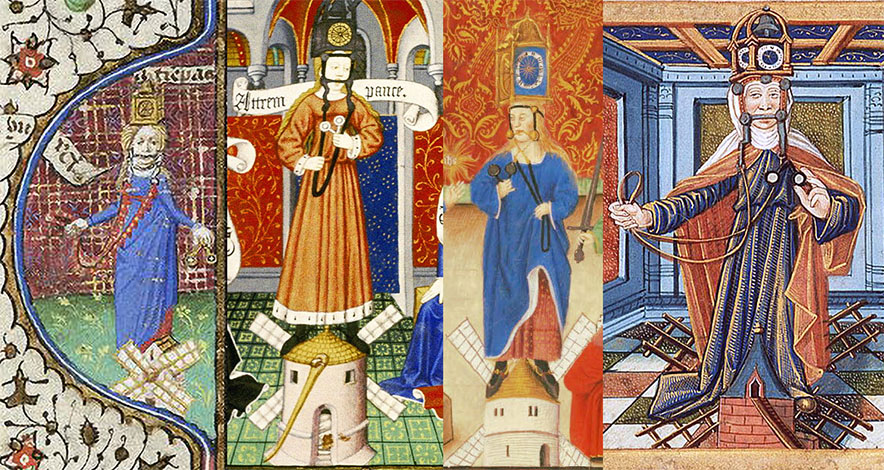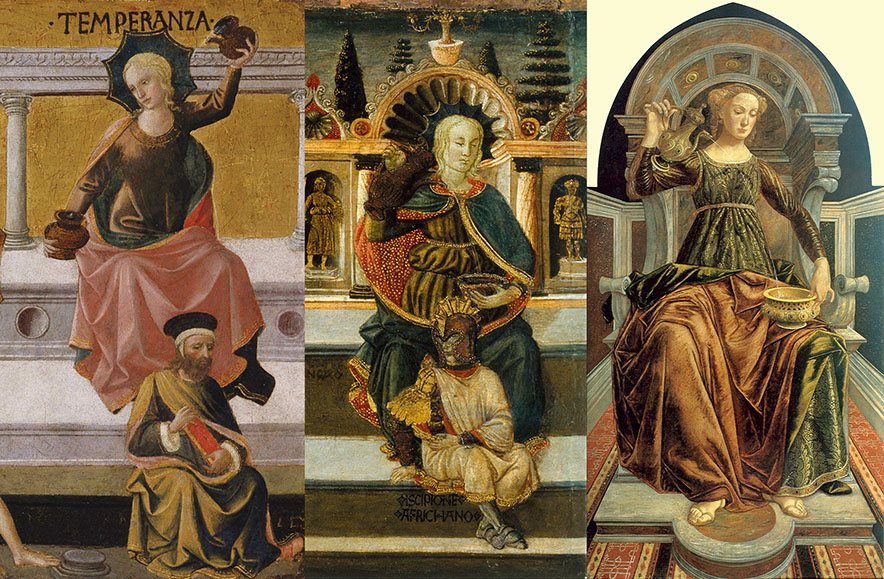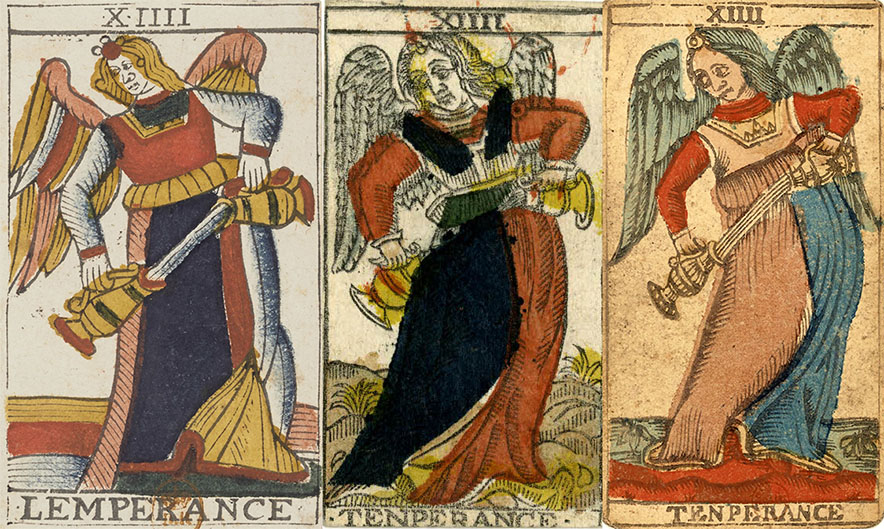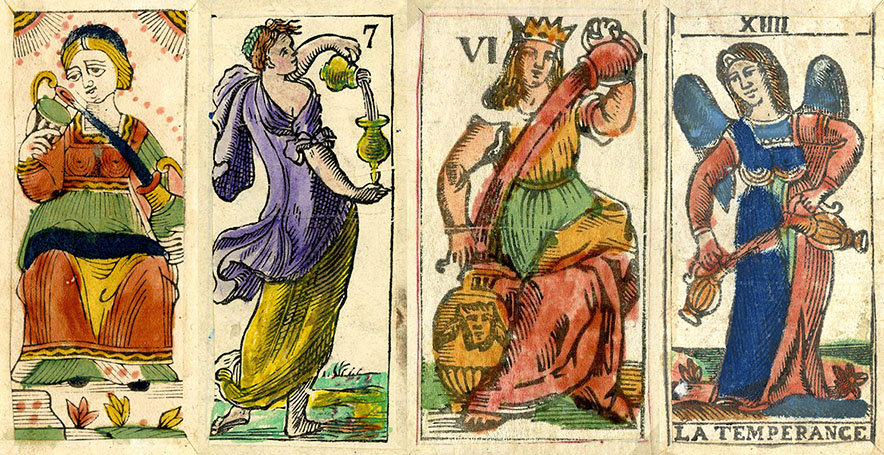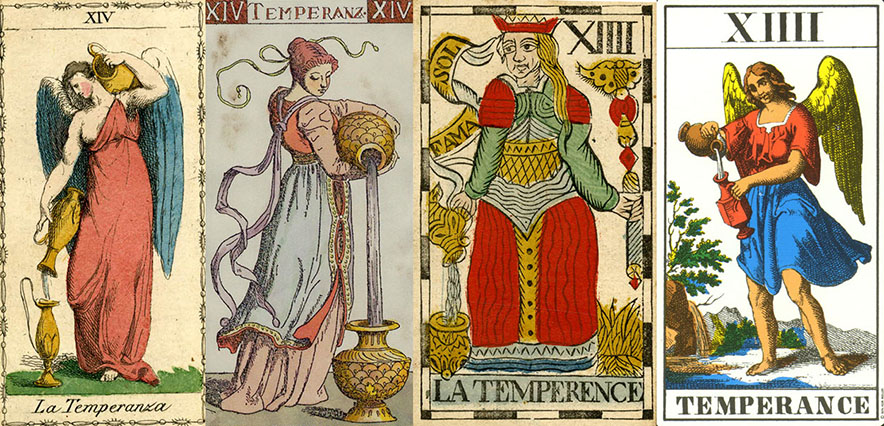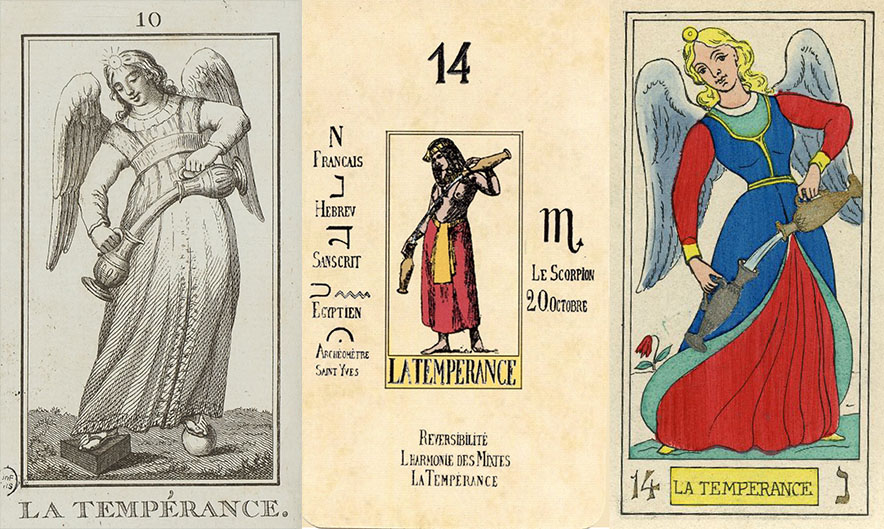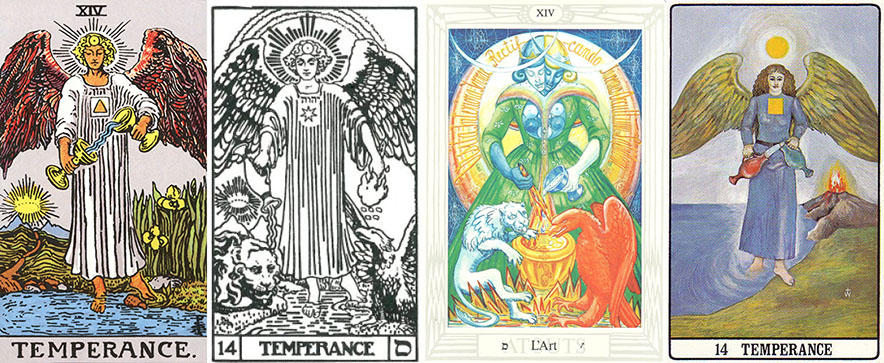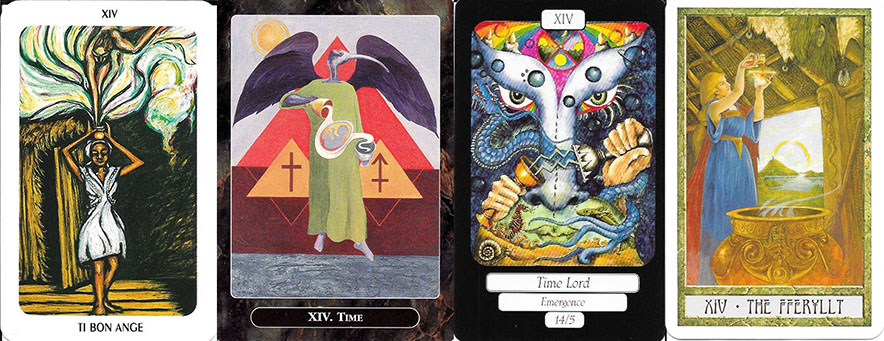THE TAROT WHEEL
LA TEMPERANTIA - TEMPERANCE
Temperance is one of the three cardinal virtues we encounter in the Tarot. We start our journey through time with a sculpture made in 1467 by Domenico di Paris, ordered by Duke Borso of Este and part of the decoration of the room of virtues in the Schifanoia Palace in Ferrara. We see here Temperance as a Lady diluting wine with water. On this page we will not tell the story of the virtues, but we will have a look how Temperance was represented in art and how this representation developed in Tarot. To do so, we start with a look at the oldest hand painted Trionfi cards, direct ancestors of the Tarot. Five cards survived, the best known are the following:
The three Temperance cards presented here are, from left to right, Temperance of the Este deck, created in 1473 on the occasion of the marriage between Duke Ercole I of Este and Eleonora of Aragon, daughter of Ferdinand I, King of Naples. In the middle Temperance of the Charles VI deck, probably also commissioned by Ercole I of Este. On the right side, Temperance of the Visconti Sforza deck. This card probably has been added to the existing deck between 1475 and 1490. All three cards show a similar Temperance, pouring a liquid, probably water, from a vessel in their right hand into a similar receptacle, probably containing wine, in their left hand. We remark on the two left cards that Temperance is wearing a spider web shaped headgear, in that time a typical attribute for an allegorical representation of a virtue. We also remark that, in contrast with many other Trionfi cards, none of the virtues have symbolic references to the commissioner of the cards.
From left to right Temperance (the Stag rider) of the Alessandro Sforza deck, a late 15th Century copy of the Visconti Sforza card and a print of the so-called Mantegna Tarot. On the Alessandro Sforza card, we see a naked female figure sitting on a deer (stag). She is, like on the other Temperance cards, pouring a liquid from a vessel in her right hand. However, in her left hand she holds apparently nothing and the liquid is passing between her legs onto the body of the deer, as if she is washing her genitals. The second card belonged formerly to the Von Bartsch collection. The card has been sold to a private collector in Milan, and we don't know where it actually is. There is no recent picture known of this card. The third image is not from a card deck, but from one of the prints of the so-called Mantegna Tarot that are made by an anonymous artist. The oldest prints date from 1465. The image shown here is from a series of prints dated to 1470, mirrored with respect to the first series. As such, these prints are contemporary to the Ferrara Trionfi cards.
Even with the strange interpretation in the Alessandro Sforza deck, all Trionfi cards and the Mantegna Tarot are extremely homogeneous, with women pouring water from one vessel in another. The printed decks, contemporary to the painted ones, give the same picture:
The printed cards we know are all from uncut sheets of cards. Here we have only one complete card and two fragments. However, the fragments show the essential part of the image. All three cards belong to sheets found in the bindings of old books. The leftmost image belongs to the Rosenwald sheet. I have mirrored the image to make it in agreement with the Leinfelden sheet, a very damaged sheet of the same deck. The second image is from one of the Budapest sheets, and the last image is from the Cary Yale sheet. Also, here in each image, Temperance is represented as a woman pouring a liquid from one vessel into another receptacle. However, in Medieval and Renaissance art, Temperance had several representations, not only this one:
Between 1270 and 1285, a certain French Dominican friar Laurent wrote a treatise about the virtues and vices, called La Somme le Roi (A Survey for a King). This manuscript was written originally for the children of the French king Philip III of whom he was the tutor, but it became extremely popular in the noble ranks of the population. In between its first version and the year 1500, this manuscript was copied some 400 times. Here above three representations of the virtue Temperance as it appeared in these texts, all three from 13th Century copies of the original manuscript. We see here two ladies conversing behind a well filled table, and a young servant kneeling and offering a drink to the ladies. The crowned lady at the left offers all the good things on the table to the lady on the right side, but apparently she refuses and tells her queen to moderate her consumption.
Three other representations of Temperance, and all three of them very different from Temperance on the Trionfi and early printed decks. From left to right we have a 13th Century stained-glass window from the cathedral Notre Dame in Paris, the representation of Temperance painted around 1306 by Giotto in the Scrovegni Chapel in Padua and a detail of the 1338 fresco painted by Ambrosio Lorenzetti representing the Allegory of Good Governance. On the stained-glass image, Temperance has a shield with a dromedary painted on it. The dromedary can retain its thirst for weeks, and as such is a very good symbol of moderation. In the allegory of Temperance, painted by Giotto di Bondone, a woman is holding a sword in a scabbard, as if she wants to say to use this weapon in a moderate way. In her mouth, she has something that looks like a bridle, to restrain immoderate speech. The image on the right side is the oldest painting we have of an hourglass. The sand glass allows Temperance to keep time and to avoid exaggeration. Temperance with a timepiece and/or a bridle became a representation of this virtue that was many times used afterwards.
Four identical representations of Temperance from different manuscripts. The leftmost is from a Paris Book of Hours and has been realized around 1430-1435. The second one is from an Italian breviloquium (prayer book) and was made in 1450. The next one was painted in 1452 in Rouen and comes from a manuscript dealing with the ethics of Aristotles. The last image is a detail from a 1520 manuscript called "Le Séjour du Deuil pour le trépas de Messire Philippe de Comines, seigneur d’Argenton". On all four images we see Temperance standing on a windmill, with glasses in her hand, a bridle in her mouth and a clock on her head. The pair of glasses allows her to clearly distinguish the facts, the bridle avoids immoderate speech, the clock enables to regulate the life of wise men and the windmill is indicating how important it is to work regularly. The same attributes were used in many more representations of Temperance, especially in French and other Northern European manuscripts and engravings. However, Italian paintings show us another representation of this virtue:
All three paintings are a detail of a bigger work showing the seven virtues, and all three artists are from the Florentine school. From left to right, we have a 1450 Temperance painted by Francesco Pesellino, a 1465 Temperance painted by Anton Francesco dello Scheggia and a 1470 Temperance painted by Piero del Pollaiolo. The artists of the Florentine school had a great influence on all art in Northern Italy and all over Europe, so it is without surprise that, even with so many other types of representations of Temperance elsewhere in Europe, all early Trionfi decks used the same type of representation for the virtue of Temperance. So let us return to the Tarot, to see how the representation of the virtue Temperance developed over time.
Let us start in France. The city in France with the longest history of card making is Lyon situated in the South Eastern part of France, not far from Italy. The leftmost card is from the deck of Catelin Geofroy, realized in this city in 1557. Temperance is here represented according to the Italian tradition. The second card is from the anonymous Tarot of Paris, realized in the first half of the 16th Century in Paris. Temperance is now holding a jug with two hands, and apparently she is fighting against a fire. The third card is made by Jaques Vievil, probably around 1645, also in Paris. On the card, we see a banner with written in mirror on it the Italian words Sol Fama (only fame). This was a direct reference to a text of Matteo Boiardo that starts with the words "Dopo la morte sol fama n’avanza,..." (After death only fame advances,...). Sol Fama refered thus indirectly to the poem I Trionfi of Petrarca, where the Triumph of Fame followed the Triumph of Death and this to justify that Temperance is trumping over the preceding card, number XIII or Death.
In the same period, in the middle of the 17th Century, the Tarot of Marseille (TdM) was born. The oldest-known representative, the Tarot of Jean Noblet, created around 1657 in Paris, is shown here above as the first of the three pictures. The second card is from an 18th Century TdM type I deck made by the Lyonese card maker Guilaumhe Dubesset. At the right we have a Temperance card from the Tarot de Besançon deck (a variation of the TdM) made in 1746 in Strasbourg by the card maker François Laudier with as engraver Pierre Isnard. The great difference between the Tarot of Marseille and its Italian model is the appearance of wings on the back of the Temperance figure. The explanation of the wings, that did not exist in the Italian model, is rather simple. In giving Temperance wings, she is promoted from a virtue to an (arch)angel, thus justifying that Temperance (card number 14) trumps over Death (card number 13).
In the same time that Tarot gained terrain in France, it lost it in Italy. Only in some places, the game survived in a regional format. The heart of Tarot-related game playing in Italy was Bologna. Very early in the 16th Century, the imagery of the Tarocchino game, a Tarot game where some pip cards were removed, stabilized in a format, still played today. The leftmost card is an 18th Century example of this standardized imagery. This particular deck was created by Antonio di Maria somewhere between 1725 and 1770. A new version was created around 1665/1670 by Giuseppe Mitelli. The second card was based on the Mitelli model and created in the early 19th Century by a certain Francesco Barattini. Another game, based on Tarot, that evolved in the 17th Century, was Minchiate. In this game we see an extended trump card set that conserves all the regular Tarot trumps while adding other imagery (the four other virtues, the four elements and the 12 Zodiac signs). This game was created in Florence but was also produced in Bologna and to a lesser extent elsewhere in Italy. The third card is an example of an 18th Century anonymous Florentine Minchiate game. The last card was made in Bologna, by Francesco Berti in the late 17th Century. This card marked the return of the Tarot game in Italy under the name Tarocco. In the beginning, the cards were based on the Tarot of Marseille model and conserved the French titles. We remark that all Italian cards conserved the representation of Temperance as proposed in the 15th Century by Florentine artists.
Almost all 18th and 19th century Tarot cards used the Italian model for the Temperance card. As examples, we see from left to right the 1810 Milanese Lombardy Tarot, the 1893 Vachetta Tarot created in the Torino region, the 1780 Vandenborre Belgian Tarot made in Brussels, and a 1965 reprint of AG Müller of the 19th Century Swiss 1JJ Tarot, created in Diessenhofen close to the German border. The Lombardy Tarot used the TdM as its model. The 1JJ Tarot, produced between 1831 and 1860 in the card factory of Johann Georg Rauch (who sold the factory in 1838 to Johannes Müller), was based on the Tarot of Besançon (JJ stands for Jupiter and Juno, replacing the Pope and Popess). The Belgian Tarot had the Vievil Tarot as a model. The Vachetta Tarot had a more original design, but was still based on the Italian Temperance model, where we see a lady diluting wine with water. With these cards we enter the epoch of the French occultist Tarot decks that would influence the Tarot until today.
Between 1773 and 1782 Antoine Court de Gebelin wrote a series of books entitled "Monde primitif analysé et comparé avec le monde moderne". In part 5 of this series, there were two chapters about the Tarot, introducing an Egyptian origin of the Tarot. He also suggested that there was a link between the Tarot trumps and the Hebrew alphabet. These books were followed between 1783 and 1785 by another series of books written by Jean-Baptiste Alliette under the pseudonym Etteilla, entitled "Manière de se récréer avec le jeu des cartes nommées Tarots". In the third part of this series, written in 1783, we find the drawing here presented as the leftmost image entitled "La Tempérance". These cards will later become known as "Le Grand Etteilla" or also as the Egyptian Tarot. Etteilla changed the card images and numbers. For the card Temperance he kept the image of the TdM card but changed the number of the card to 10 (the four capital virtues were numbered 9 to 12, with the virtue Prudence, non-existing on the TdM, as number 12). One century later, French occultists still accepted this Egyptian origin and the link with the Hebrew alphabet. Alphonse-Louis Constant, better known as Eliphas Levi, in his 1854 book "Doctrine and Ritual of Transcendental Magic", deepened this theory and assigned a Hebrew letter to each Tarot trump. In 1889 two occultists published a Tarot deck based on this theory. In the middle we have Temperance from the Bohemian Tarot created by Gérard Encausse under the pseudonym Papus, and at the right we see Temperance as created by the Swiss occultist Oswald Wirth, who was living and working in Paris. On both cards we see the Hebrew letter Nun, assigned by Eliphas Levi to the Temperance card. All three cards here above have added symbols, attributed by the occultists who created these decks.
Arthur Edward Waite was an Englishman born in Brooklyn, New York. At the death of his father, he returned with his mother to England and was raised in private schools in London. At a young age he became interested in esotericism and in 1881 he discovered the writings of Eliphas Levi, that would have a great influence on his life. In 1891, he entered the Hermetic Order of the Golden Dawn. He guided Pamela Colman Smith in the creation of a Tarot deck where, in order to facilitate the interpretation of the cards, all pip cards were represented by drawings. The leftmost card is Temperance as it appeared in this deck, better known as the RWS deck, published in 1909, that became (and still is) the most influential Tarot in the English-speaking world (and far beyond). The images on the trump cards were largely based on the imagery of the TdM. The Order of the Golden Dawn embraced the Tarot as one of their tools in magic practices. All cards presented here above were made by people who once were member of the Order of the Golden Dawn. In 1947 Paul Foster Case, founder and president of the Builders of the Adytum (B.O.T.A.), published a black and white deck based on the RWS deck, that 'corrected' some errors in the original deck. The Temperance card, second to the left here above, obtained some alchemical symbolism, and a lion and an eagle were added to the card. The Order of the Golden Dawn changed the attribution of the Tarot trumps to the letters of the Hebrew alphabet, and on this deck we see for the first time these new assignments. Temperance was attributed to the Hebrew letter Mem. The third card presented here above was created in 1944 by Frieda Harris under the guidance of Aleister Crowley, a very controversial member of the Order of the Golden Dawn. That deck, called the Book of Thoth, of which the Temperance card is very close in symbolism to the B.O.T.A. deck, was only published in 1969. The rightmost card is from the Golden Dawn Tarot, published in 1977, and created by Robert Wang under the guidance of Dr. Israel Regardie, author of many books, revealing the secrets of the Order of the Golden Dawn. This deck was, according to the authors, exactly conform to the teachings of the Order of the Golden Dawn.
The vast majority of modern Tarot decks base their imagery on the RWS deck, in keeping the winged angel pouring a liquid from one vessel in another and calling the card Temperance. Starting with the deck of Aleister Crowley, who called the card Art, and changed the symbolism, some other artists also changed the deck's name and symbolism, to have it in agreement with their proper thematic choice for the deck. Here above we see four examples. The first card on the left is from the New Orleans Voodoo Tarot, published in 1992 by Louis Martinié and Sallie Ann Glassman. The card is called Ti Bon Ange. In the Haitian Creole Voodoo culture, Ti Bon Ange is one of the dualistic aspects of the human Soul, responsible for one's personality and will power. The other aspect is Gros Bon Ange, responsible for the blood circulation and the respiration of a person. The second card is from the Universal Tarot, published in 1996 by Samuel Weiser. Here the card is called Time, that is in agreement with one of the earliest representations of Temperance, as we have seen earlier on this page. The third card is from the MerryDay Tarot, published in 1997 by Louisa Pool. Like on the previous card, the name of the card refers to the cosmic clock, and it is called Time Lord. The last card is from the Druidcraft deck, first published in 2004 in the UK (and one year later in the US) by Philip and Stephanie Carr-Gomm. Fferyllt is a name from Celtic origin referring to a druid alchemist, who is portrayed on the card. Visually, all four cards keep in one way or another the TdM symbolism of a liquid being transferred from one vessel to another.
With these four cards we end our journey though time, accompanied by the Temperance card. We have seen that Temperance was represented in several manners in Medieval and Renaissance Europe. However, the Tarot adopted straight from the beginning the symbolism of a Lady transferring a liquid from one vessel into another receptacle, usually interpreted as wine being diluted by water. This symbolism has been conserved by all subsequent Tarot designers and is still in use in virtually all modern Tarot decks.
